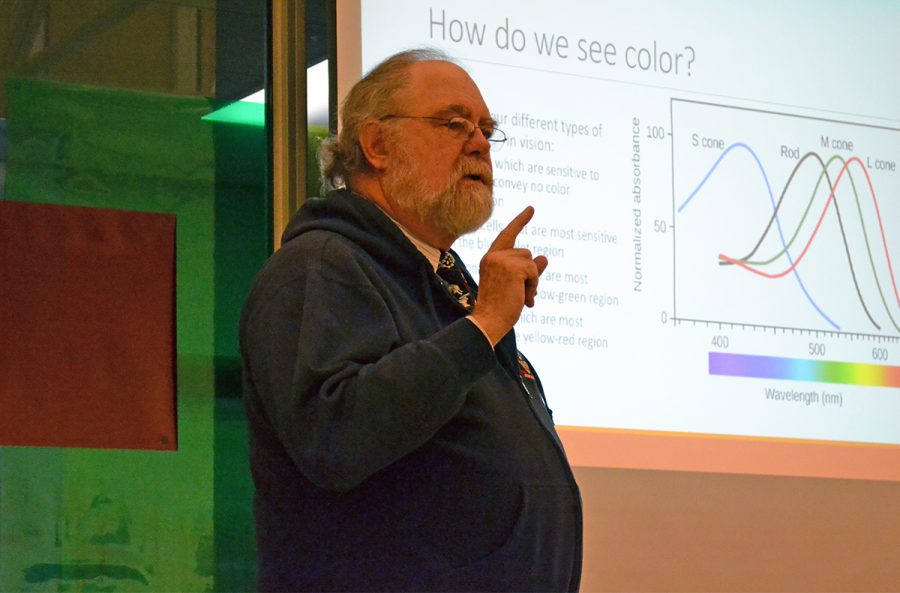Chemistry and color come together in ‘Color through the ages’
The Foster Gallery hosted a chemistry professor to discuss color and science
More stories from Casey Ryan
Photo by Kar Wei Cheng
Chemistry professor David Lewis shared how chemistry affects color and technology at the Foster Gallery.
One of UW-Eau Claire’s chemistry professors shared how the chemistry and technology of color have developed over the years at the latest Foster Art Gallery presentation for its current exhibit.
Students, faculty and community members of Eau Claire filled the Foster Art Gallery on Friday, Nov. 10 at 7 p.m. to learn about the connections between art and science.
Chemistry professor David Lewis spoke at the gallery about the different ways science — specifically chemistry — affects color. He discussed three main ways science impacts color by using plants, animals and other natural influences.
“The reason trees are green is because of chlorophyll,” Lewis said. “If you ever get down to Australia, take a look at the eucalyptus trees because you’ll find they have more blue pigments than green.”
Lewis is from Australia and teaches at Eau Claire. He showed cave paintings from Australia and told the audience the chemicals that made up each color that was used.
Madder is a plant that was used to color and dye things red, he said. Their roots are bright red, and when grinded up they can be used to dye fabrics.
“They grab the roots, grind them and then extract them and then what they got was a raw madder material to be able to dye and color,” Lewis said.
The British Army used madder lake often to dye their coats red, which got them the name “Redcoats” Lewis said.
Another color, tyrian purple, was an extremely expensive dye in 1500 B.C., he said. This dye was made out of mollusks and nearly 12,000 of them were needed to produce 3.5 oz. of dye.
“The mollusks had to be harvested by hand; there was a reason that the only people that could afford this was royalty,” Lewis said.
Indigo plants are in the United States, in the northern Rocky Mountains, he said. Indigo was a rare commodity in Europe through the Middle Ages.
“Indigo was not cheap, and you had to find the right buyer,” Lewis said “It was a luxury dye that was mostly used for painting and cosmetic purposes.”
Lewis said the majority of the cosmetics used throughout history were all toxic chemicals. People used a lot of lead-based paints, sulfides and arsenic.
“Cadmium pigments must be produced from pure grades of chemicals, because the final colorants must be free of transition metal compounds which form deeply colored sulfides and when mixed with water dilutes the color,” Lewis said.
Hailee Daming, a sophomore psychology student, said she enjoyed the speech Lewis gave.
Having frequented other gallery talks from the exhibit “Color”, she said this one was the most stimulating out of the others. Daming said that Lewis kept everyone’s attention with jokes and images of chemistry reacting with color on the projector.
Julia Stadler, a sophomore art illustration student, was the gallery attendant for the talk and said it was the first presentation she worked at.
“I really like the art and science together. I think they mix really well together, and a lot of people don’t really know that,” Stadler said.
When the speech ended, attendees were encouraged to walk around and look at the infrared camera that maps body heat. They were also encouraged to participate in some of the interactive pieces such as coloring on the large-scale coloring book.
The next gallery talk will be on Nov. 15 at the Foster Gallery with painter Mary Pettis, an expressive realist. She will be exploring the connections between music and color.

